Sir Dominick Cavuoto, KHS
President
Diocese of Venice Section
Equestrian Order of the Holy Sepulcher of Jerusalem
4888 Pond Apple Drive North
Naples, FL 34119
239-777-1580
History of The Equestrian Order of the Holy Sepulchre of Jerusalem
Among the ancient chivalric Orders, the Equestrian Order of the Holy Sepulchre of Jerusalem occupies an extraordinary and exalted position, having been chosen to guard the most sacred spot in the Holy City of Jerusalem, and, indeed, in all of Christendom, the tomb of Christ.
The Order of the Holy Sepulchre is of such antiquity that its very origin is disputed among scholars. It has been claimed that in 81 A.D. Pope Anaclet assigned the custody of Christ’s tomb to a confraternity of hermits who constituted the forerunners of the present Order. It is, however, in 1099, with the capture of Jerusalem by the first Crusade, that the history of the Order emerges from the uncertainty of legend. It was natural that the Christian warriors who had braved so much to free the holy places from Moslem domination should desire to receive the tokens of knighthood in the church of the holy Sepulchre, and that they should feel a special devotion to this very sacred spot. The devotion the Crusaders felt for this shrine is shown in the case of Godfrey de Bouillon, the leader of the Crusade, who refused the crown of king of Jerusalem but accepted the title “Defender of the Holy Sepulchre.” Those Knights who received their investiture at the Holy Sepulchre itself, and who constituted a guard of honor the shrine, were approved as an Order in the Bull of Approbation by Pope Pascal II in 1113.
Many donations were made to the support of the Order of the Holy Sepulchre both in Palestine and Europe, but none was more famous, nor more indicative of the high regard in which the Order was held, than that of King Alfonso of Aragon who willed one-third of his kingdom to the Order in 1134. Likewise Pope Celestine presented the oratory of St. Egidio in the Vatican to the Knights of the Holy Sepulchre in 1144, and their principal chapel in Europe.
The Knights of the Order of the Holy Sepulchre were active participants in the long struggle to maintain the Latin Kingdom of Jerusalem, but with the fall of that Christian stronghold the order was forced to return to Europe and religious communities of the Holy Sepulchre were founded in many countries, including France, Spain, Belgium, Germany and Poland. In these communities the austerity of a religious rule was maintained.
It was to the Order of the Franciscans that the custody of the Holy Land was entrusted following the fall of the Latin Kingdom. During the long period of guardianship the Superior, or Custos, of the Franciscans continued to bestow the Order of the Holy Sepulchre – a right confirmed by Pope Leo X. However, in 1847 the Order underwent a rebirth with the re-establishment of the Latin Patriarchate by Pope Pius IX. The office of Grand Master of the Order was transferred from the Custos of the Franciscans to the Patriarch, and in 1868 new statutes were approved for the Order by the same Pope.
The statutes created three classes of Knights, and in 1888 Pope Leo XIII authorized the conferring of the Order upon women, who were to be styled Dames of the Holy Sepulchre and to share in all the rights and privileges of the Knights.
Pope St. Pius X took upon himself the office of Grand Master in 1907, and further honored the Knights of the Order should henceforth be suspended from a military trophy, in commemoration of the Order’s past military role, and by granting the Knights the use of the white cape with the cross of the Order displayed on its left side.
The pontificate of Pope Pius XII was of enormous significance for the Order of the Holy Sepulchre as it was under that Pope that the purpose of the Order in the modern world was clarified. On 16 June 1940 His Holiness named His Eminence Nicholas Cardinal Canali Cardinal Protector of the Order, and by Motu proprio of 15 August 1945 the Church of St. Onophrio in Rome was designated as the official center of the Order. These steps were then followed by the
Apostolic Brief Quam Romani Pontifices on 14 September 1949 which promulgated the new statutes of the Order and created the office of Cardinal Grand Master, vested in Cardinal Canali. By these statutes the purpose of the Order is “to revive in a modern manner the spirit and the ideal of the Crusades, with the arms of the faith, of the apostolate, and of Christian Charity.” Specifically the Order “is zealous for the preservation and the spread of the faith in Palestine, supports and furthers the missions of the Latin Patriarchate of Jerusalem, and gives assistance to its good works and to it charitable, cultural and social undertakings,” and “champions the defense of rights of the Catholic Church in the Holy Land, the cradle of the Order.”
In 1962, following the death of Cardinal Canali, Pope John XXIII chose His Eminence Eugene Cardinal Tisserant, Dean of the sacred College of Cardinals to act as Cardinal Grand Master of the Order. A revised constitution was approved by Pope John XXIII in the Apostolic Brief Religiossimo a Monumento Victorae of 8 December 1962. In that Constitution the juridical personality of the Order was confirmed and the protection of the Holy See reaffirmed. This was reinforced by Pope Paul VI in the revision of 19 November 1967.
The Holy See acts as Protector of the Order, while its government is in the hands of a Cardinal Grand Master, who receives his office from the Supreme Pontiff. The seat of the Order is at Rome while the historical seat remains at
Jerusalem where the Latin Patriarch resides. The Patriarch is Grand Prior of the Order and exercises special faculties for the reception of new members and the care of the Golden Book of the Knights and Dames of the Holy Sepulchre.
Following the death of Cardinal Tisserant in 1972, Pope Paul VI chose His Eminence Maximilian Cardinal deFurstenberg to succeed to the office of Cardinal Grand Master of the Order of the Holy Sepulchre.
In 1988, after the death of Cardinal deFurstenberg, Pope John Paul II chose His Eminence Giuseppe Cardinal Caprio as Grand Master of the Order of the Holy Sepulchre of Jerusalem. Upon his retirement from the office in 1995, His
Eminence Carlo Cardinal Furno was named Grand master of the Order. Worldwide there are now 22,000 Knights and Ladies of the Order in 52 countries.
In 1926 the Order was founded in the United States of America, and has today grown to ten lieutenancies.
At its Annual Meeting and Investiture in Corpus Christi in1986, the Southern Lieutenancy because of growth, reapportioned its states into two Lieutenancies, Southeastern and Southwestern.
From 1986 until 1993 the Southeastern Lieutenancy consisted of Louisiana, Mississippi, Alabama, Georgia, Florida, Tennessee, South Carolina, North Carolina, Virginia, West Virginia, the Archdiocese of Washington, D.C. and the U.S. Virgin Islands.
In 1993, at the Annual Meeting in New Orleans, the Middle Atlantic Lieutenancy was created with certain States annexed from the Southeastern and Eastern Lieutenancies.
Today, the Southeastern Lieutenancy comprises the States of Louisiana, Mississippi, Alabama, Georgia, Florida and
South Carolina and with a membership of over 1,574 Knights and Ladies, with 248 Clergy Knights.
Members are chosen from “among persons of a deep and practical Catholic Faith and of unblemished moral conduct, who are particularly worthy of merit in respect to the Order and Catholic good works in the Holy Land.”
The religious character of the Order of the Holy Sepulchre is obvious not only in its objectives and requirements for membership but also in the ceremonial investiture of its newly elected Knights. This ceremony combines a profession of faith with the ancient ritual used for the conferral of knighthood. The candidates do not take monastic vows but promise to live an upright Christian life in accordance with the commandments of God and the precepts of the Church, in absolute fealty to the Supreme Pontiff, as true soldiers of Christ.





